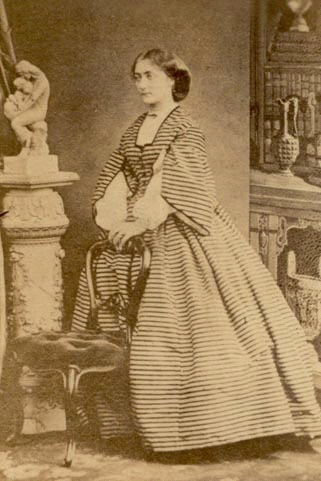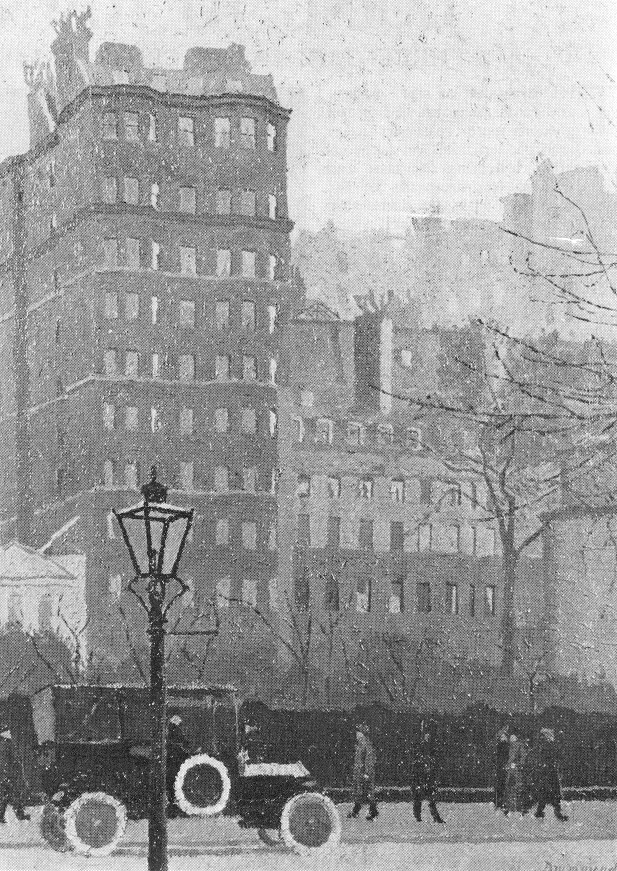Navigation: Alers Hankey > Miss Alers > William Alers > John Alers >
1831 - 1902
Second son of John Alers Hankey and his wife Sarah Andrews nee Jameson, Henry was born at 7 Fenchurch Street on 25 Oct 1831 and was baptised on 20 Feb 1832 at the Independent chapel at Kings Weigh House, Fish Street Hill. He and his brother Charles were at York House School at Cowes in 1841.

Mrs Henry Alers Hankey nee Meinertzhagen
Henry married Johanna Meinertzhagen (daughter of the banker Daniel Meinertzhagen, later of Belmont, Wimbledon Common) on 12 Oct 1859 at Trinity Church, Marylebone. After their marriage they were living at 38 Harley Street. Their only child Hermine was born there in 1860, as was the eldest child of Henry’s younger brother Jameson Alers Hankey, following the latter’s return from India. After a period at Queen Anne’s Mansions, they lived from 1878 at 23 Park Crescent, Portland Place. Johanna left there in 1912 and moved to a small house at Durham Villas, Camden Hill.
Henry was a partner of the firm Lane, Hankey & Co, London-Baltic merchants and shipping agents, of 25 Old Broad Street and 8 Chesham Place. He was a Lieutenant for the City of London. A report from the Female Middle-Class Emigration Society in London in 1880-82 was signed by Henry Alers Hankey as Treasurer.
Henry was a considerable authority on the history of the Hankey family, and commissioned a very extensive research of the Chester archives for all references to the name Hankey over several hundred years. He substantially compiled the Hankey and Alers Hankey family trees, which were completed and printed by Basil Alers Hankey in 1912. He also undertook massive research into his ancestor Rev Mordecai Andrews and his descendants. Henry died on 7 Oct 1902.
‘My Aunt Johanna, whom we all knew as Tanner, was born in 1840 and married Henry Alers Hankey at Trinity Church, Marylebone, on 12 October, 1859. My Uncle Henry was a selfish, unattractive little man, though not without talent. He was responsible for building Queen Anne’s Mansions, on top of which he built himself an observatory from which he could overlook London, for when the mansions were built they were the tallest in London and were dubbed ‘Hankey’s Folly’. From his observatory he would watch every night for fires and inform the Fire Brigade, but one night the obvious occurred: a fire broke out below him, destroyed his observatory, and he barely escaped with his life. It was the one fire he had failed to observe and report. A little girl, Hermine, was born on 27 August, 1860, but died at Belmont [Wimbledon Common] in 1868. My Aunt Johanna’s marriage was a mistake. She once told me that she would never have married if she had not thought that all men were like her father. In those days the selection of husbands was largely in the hands of parents. Johanna had been on ‘looking and winking’ terms with a young man whom she had only met in church. She did not even know his name but was in love with him. But Henry Hankey was also attracted to Johanna and went to her father asking his permission to beg her hand in marriage and as a good daughter she accepted. But Henry was not the young man with whom she had been on ‘winking’ terms in church.
Tanner was a very dear, kind person, full of good advice, and always in good spirits. For years she lived in Park Crescent and she never failed to attend our Christmas parties at Mottisfont. She died in London in 1918.
Queen Annes Mansions
Henry was responsible for the development of Queen Annes Mansions, Broadway, Westminster: ‘A massive block of flats, 14 storeys high, built for the developer, Henry Alers Hankey, in 1873-1889. Black with the dirt of ages and without any exterior decoration, it is for real ugliness unsurpassed by any other great building in all London. It was demolished in 1971.’ Lord Curzon told a meeting of the London Society that ‘it seemed almost incredible that in a great, cultured, modern, civilised city such horrible phantasmagoria like Queen Anne-Mansions should ever have been allowed to rear its hideous head in the air.

Queen Annes Mansions c.1912, by Drummond
‘About nine o’clock last evening it was widely rumoured through London that the military barracks at Chelsea, or those known as the Wellington, in St James’s Park, were on fire. Some colour of truth was given to these suppositions by the appearance in a south-westerly direction of a high steady column of flame, which for two hours continued to burn. The event, however, proved that not the military establishment, but the palatial mansion of Mr. Henry A. Hankey, at Queen Anne’s Gate, was rapidly being consumed. This house stands backward amid a space of gardens, and fronts Birdcage-walk; and the chapel of Welligton Barracks is in the immediate neighbourhood. It was quite new; in fact, workmen were still engaged upon it, giving the finishing touches before the owner and his family definitely removed into it. The contractors with a staff of 150 men have had it in hand for about two years and a half; and some idea may be gained as to the magnitude of the work and the value of the property destroyed when it is mentioned that the house and contents were insured with the Liverpool and London and Globe Insurance Company for a sum between 40,000l. and 50,000l. The architecture of the building was in the Gothic style, upon the model of Goodrich Court, Herefordshire, which was designed by Sir Samuel Meyrick. There were five stories in the main portion; and, in a part communicating with the present dwelling of Mr. Hankey, there were two stories. On the ground floor were the dining-room, the billiard-room, and the drawing-room ‘ an apartment 50 feet long ‘ the reception-hall and grand concert-room, which were 70 feet in length and 30 feet high, and included at one end a stage 30 feet by 20. Above these were three stories, chiefly occupied as bedrooms; the basement was, up till the time of the fire, unused. In the concert room was a magnificent chamber-organ, by Wedlake. It cost 3,500l., and is said to have been the largest in the world of its kind. This fine instrument was burned, but the books and pictures, with the exception of two of these latter, were saved by the exertions of the military from the adjoining barracks, a number of Mr Hankey’s workmen, and others. The house was almost fully furnished, but not completely. Most of the furniture has been saved. The fire was discovered shortly before nine o’clock in the evening.
Mr Hankey’s family had not yet risen from dinner when the reflection of flames on the opposite wall from an upper storey of the house immediately revealed the state of matters. Upon this discovery messengers were sent to various fire and police stations; but, meantime the Coldstream and Grenadier Guards from the Wellington Barracks arrived with their engines, and did immense service in arresting the spreading conflagration. Soon, also, there were on the spot some ten fire steamers worked by about 60 or 70 men. A body of police, numbering between 300 and 400 men ‘. kept at a convenient distance the thousands of persons who had flocked to the scene. Notwithstanding the energy of the firemen the flames spread and burned fiercely; so that in an hour the entire building was illuminated through its various windows, and the roof gave way. This lent an impetus to the fire, which now blazed with a surpassing scenic effect; for, amid the tongues of flames and showers of sparks, the two towers of an observatory erected by Mr. Hankey on the top of his house loomed darkly ominous.
A large telescope upon one of these pointed a threatening finger upwards until, the balcony surrounding it having fallen, it disappeared among the ruins. Out of twenty bed rooms in the establishment only two were saved, as were also the dining and billiard rooms, but the drawing-room and the concert-hall and reception-room were entirely burned. At 11.30 o’clock the fire had spent its strength, and, save an intermittent shooting of flame among the ruins, no trace of its existence was visible. The walls continued to stand, but, of course, the floors of the various stories and everything contained therein, perished. It was a rather melancholy spectacle to witness the corridor leading from 60, Queen Anne’s-gate ‘ the burned premises ‘ to the adjoining No. 62, flooded with water, overlooking which, on their pedestals were the figures of classical heroes cast in plaster. The effects which have been saved are deposited in the house now occupied by Mr. Hankey. It is supposed that the fire originated in one of the rooms with which the workmen had not yet done in the upper storey, and thence extended downward. Mr. Hankey has at present in course of construction a large ten-storied house communicating at a distance of some 20 yards with the burned premises. He had intended to let this out in chambers for members of parliament and others, but he will now live there himself. It is said that the pitch pine timber entered largely into the construction of Mr. Hankey’s house, and to this is attributed the amazing rapidity with which the flames spread.
It is just a little curious that Mr Henry Alers Hankey, whose house and observatory at Queen Anne’s Gate were burnt down last week, has been for many years almost as great an amateur or follower of fires as the Duke of Sutherland himself. Many years ago Mr Hankey built himself an observatory on the top of his house in Portland Place, which he delighted to use as a smoking room of an evening, having a brougham ready below to start off directly he noticed the glare of a fire from his watch tower. But the physician in this instance could not guard himself, and Mr Hankey has now fallen a victim to the ‘devouring element’ whose ravages he has for years been so fond of watching.